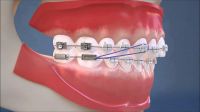Impacted tooth
One of the most common dental diseases is an impacted tooth. Such a tooth implies the mandatory intervention of a dentist or orthodontist, as this is considered a tooth anomaly. Such an anomaly appears when the tooth cannot cut through and fall into place on its own. Such a tooth remains completely inside the bone or is slightly covered by a mucous membrane. Often this problem occurs when a wisdom tooth erupts.
The reasons for the appearance of such a tooth are different, but mainly it is the removal of milk teeth too early or incorrect position of the teeth, if the dentition is shifted, and there is no room for another tooth.
Previously, pulling out a tooth was a problem associated with the fear of visiting the dentist, now everything is much easier, but it all depends on the complexity of the situation.
Removal of an impacted tooth.
Removing such a tooth is a difficult procedure, since its incorrect location does not allow the tooth to be extracted using the usual method. This procedure is performed under anesthesia. To remove a tooth, the upper mucous membrane is cut, and the bone tissue is drilled with a bur to such a hole that the tooth can be extracted. If the tooth to be removed is voluminous, then the doctor divides it into parts and extracts it in turn. Then a medicine is put into the hole of the extracted tooth, but if the hole is large enough, then it is sewn up. Removing an impacted tooth is a long process and takes from 1 hour to 3 hours.
The recovery process is also quite painful. With difficult tooth extraction, edema may appear in this area, where the bone was drilled. Some patients experience pain when they open their mouths. Such consequences are considered normal.
The rehabilitation period can last from 1-5 days. If the pain is severe, the doctor prescribes weak local anesthetics.
It is imperative that after the extraction of the tooth, it is necessary to come to the doctor the next day to examine the wound.
What can happen if the impacted tooth is left untreated?
There is a misconception that such a tooth does not cause pain and does not bother, therefore, it is not necessary to treat it. If such a tooth is left, it will lead to the development of a focus of infection and provoke the appearance of diseases: periodontitis, pericoronitis, periodontal pocket, etc. In the place of the impacted tooth, food debris will get stuck and this will lead to caries.
If you do not take any action in terms of treating such a tooth, then serious consequences can arise, since the infection can spread to the periopharyngeal and parotid space, then the general health of the body may suffer. Also, if a chewing load is applied to this tooth, then the impacted tooth may break and then it will be even more difficult to remove such a tooth.
If a wisdom tooth bothers you, causes pain, discomfort, contact your dentist, since a problem detected in time will save you in the future from the complexity of the treatment of this tooth.
Removal of a tooth.
Sometimes they say, "pulling out a tooth" is not quite the correct wording, since some procedures must be carried out before extraction. Before removing a tooth, the dentist will inject into the gum to numb the area where the tooth will be removed.
The tooth sits very firmly in the gum and is therefore not easy to remove. To remove it, you need to loosen it well. The dentist will use special forceps to swing the tooth back and forth with a certain pressure. Such movements will help to expand the socket of the tooth, and when the socket is sufficiently expanded, the doctor will easily remove the tooth. After the tooth is removed, the dentist puts the medicine on this place.
There are few reasons for tooth extraction. This is a tooth affected by caries and cannot be restored, as well as a tooth affected by periodontal disease and broken so that restoration is impossible or an incorrect position of the tooth in a row.
The indications for tooth extraction are the threat of serious diseases, a particular tooth can serve as such a reason. If a tooth can cause a cyst to form, it can cause inflammation or trigeminal neuritis. Chronic periodontitis during an exacerbation is a common reason for tooth extraction. Dentists usually recommend removing teeth that can be the cause of the development of monotonous osteomyelitis - these are multi-rooted teeth. Teeth extraction can be offered when a fitting is made for removable dentures, but very serious indications are needed here.
For example, various methods of treatment did not help restore the tooth, and nevertheless, I had to pull out the tooth, then changes occur in the jaw after tooth extraction. So, the adjacent teeth with the extraction site, over time, begin to tilt in this direction. These changes lead to a violation of the chewing process, the load during chewing is unevenly distributed, therefore, the bite is disturbed and the general condition of the teeth worsens. In order to avoid such problems, the attending dentist will recommend repairing the defect by implanting an implant or using removable dentures.
Removing the figure eight - the wisdom tooth - is the most difficult.



